List of Egyptian inventions and discoveries
Egyptian inventions and discoveries are objects, processes or techniques which owe their existence or first known written account either partially or entirely to an Egyptian person.
Ancient Egypt
Government and Economy
Istanbul Archaeology Museum
- Community banking models – Community banking is a non-traditional form of money-lending.[1] Unlike banks or other classic lending institutions, the funds that community banks lend to borrowers are gathered by the local community itself. This tends to mean that the individuals in a neighborhood or group have more control over who is receiving the capital and how that capital is being spent. This practice has existed in some form for centuries; in ancient Egypt, for example, when grain was often used as currency, local granaries would store and distribute the community's food supply.[2] Since that time, a variety of community banking models have evolved.
- Police – In ancient Egypt evidence of law enforcement exists as far back as the Old Kingdom period. There are records of an office known as "Judge Commandant of the Police" dating to the Fourth Dynasty.[3]
- Postal system - The first documented use of a postal system—state-sponsored, designated courier service for the dissemination of written documents is in Egypt, where Pharaohs used couriers to send out decrees throughout the territory of the state (2400 BCE).[4]
- Ma'at and characterised by tradition, rhetorical speech, social equality, and impartiality.[5][6][7]
Warfare
- military units, with military hierarchy appearing in the Middle Kingdom (c.2055–1650 BC).[8]
- Military scribe and battle recording – The first well documented battle in the history of the world is the Battle of Megiddo.[9]
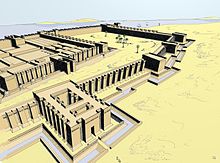
- Catapult – A Catapult dating to the 19th century B.C was found on the walls of the fortress of Buhen.[10]
- Battlements – Another feature of the Buhen fortress the construction of the world's oldest battlements.[10]
- Arrowslit – Loop holes are found for the first time in some Middle kingdom forts.[11]
- 11th Dynasty noble Khety, where a pair of soldiers advance towards a fortress under the protection of a mobile roofed structure, carrying a long pole that may represent a simple battering ram.[12]
- Siege towers – Moving siege towers were invented in Egypt during the First Intermediate Period.[13]
- Naval ram – Naval rams were built on ships since at least the reign of Amenhotep I.[14]
- Sea people.[15]
- pre-dynastic Egypt,[16] (c. 3100 B.C) daggers were adorned as ceremonial objectswith golden hilts and later even more ornate and varied construction. One early silver dagger was recovered with midrib design.
- Encryption – One of the earliest forms of encryption is symbol replacement, which was first found in the tomb of Khnumhotep II, who lived in 1900 B.C. Egypt. Symbol replacement encryption is "non-standard," which means that the symbols require a cipher or key to understand.[18]
Agriculture and Animal Husbandry
- Sadd el-Kafara Dam built in Egypt around 2700 B.C.[19]
- Noria – Norias appeared in Egypt in the 4th Century B.C.[20]
- Beekeeping - domesticated Beekeeping was first recorded in ancient Egypt around 2600 B.C.[21][22] as well as the first use of smoke while extracting the honey from bee nests.[23]
- Horse stable - The world's oldest horse stables were discovered in the ancient city of Pi-Ramesses in Qantir, in Ancient Egypt, and were established by Ramesses II (c. 1304–1213 BC). These stables covered approximately 182,986 square feet, had floors sloped for drainage, and could contain about 480 horses.[24]
- Hierakonpolis dating back to 3,500 B.C.[25]
- Olive cultivation – Some scholars have argued that olive cultivation originated with the Ancient Egyptians.[26][27]
- Ox drawn plough – Ox drawn ploughs were used by Ancient Egyptians as early as 2000 B.C.[28]
Transport
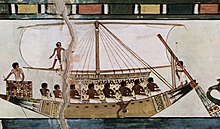
- Sail – cloth sails are depicted in predynastic Egyptian art (c. 3300 B.C).[30][31]
- Old Kingdom, third dynasty, and disappeared after the sixth dynasty when the pole mast took over during the Middle Kingdom.[35]
- Old Kingdom (2686 BC-2134 BC) as many as five steering oars are found on each side of passenger boats.[36] The tiller, at first a small pin run through the stock of the steering oar, can be traced to the fifth dynasty (2504–2347 BC).[37] Both the tiller and the introduction of an upright steering post abaft reduced the usual number of necessary steering oars to one each side.[38] Single steering oars put on the stern can be found in a number of tomb models of the time,[39] particularly during the Middle Kingdom when tomb reliefs suggests them commonly employed in Nile navigation.[40] The first literary reference appears in the works of the Greek historian Herodotus (484-424 BC), who had spent several months in Egypt: "They make one rudder, and this is thrust through the keel", probably meaning the crotch at the end of the keel (see right pic "Tomb of Menna").[41][42]
- Paved road - The world's oldest paved road was discovered near Faiyum dating back to the 26th century BC.[43]
- Rail – Evidence from The Lake Moeris Quarry Road (26th century BC.) suggests the presence of early wooden rail using wooden logs to.[44][45]
Metals, Elements and Materials
- Mercury – The earliest known use of Mercury dates to Ancient Egypt around 1500 BC.[46]
- Turquoise – Turquoise was mined in Egypt Since at least the First Dynasty (3000 BCE), and possibly before then, turquoise was used by the Egyptians and was mined by them in the Sinai Peninsula. This region was known as the Country of Turquoise by the native Monitu.[49] Serabit el-Khadim and Wadi Maghareh, believed to be among the oldest of known mines.
- Wattle and daub – Wattle and daub was used in Egypt as early as the Merimde culture.[50]
- Lime mortar – The Ancient Egyptians were the first to use lime mortars. Which they used to plaster the pyramids at Giza. In addition, the Egyptians also incorporated various limes into their religious temples as well as their homes. Indian traditional structures built with lime mortar, which are more than 4,000 years old like Mohenjo-daro is still a heritage monument of Indus valley civilization in Pakistan.[citation needed] It is one of the oldest known types of mortar also used in ancient Rome and Greece, when it largely replaced the clay and gypsum mortars common to ancient Egyptian construction.[51]
- Emerald – Emerald was first mined in Egypt since at least the New Kingdom.[52][53]
- Amethyst a form of quartz was first used by the Ancient Egyptians.[54]
- Malachite – Malachite was mined from deposits near the Isthmus of Suez and the Sinai as early as 4000 BC.[55]
- Electrum – Electrum was used as early as the third millennium BC in Old Kingdom of Egypt, sometimes as an exterior coating to the pyramidions atop ancient Egyptian pyramids and obelisks. It was also used in the making of ancient drinking vessels. Electrum is mentioned in an account of an expedition sent by Pharaoh Sahure of the Fifth Dynasty of Egypt.[56][57]
Medicine
Discoveries
- Meninges[58]
- Cerebrospinal fluid[58]
- Paralysis[59]
- Urinary incontinence – The management of urinary incontinence with pads is mentioned in the earliest medical book known, the Ebers Papyrus (1500 B.C).[60]
- bladder, and showed the blood vessels diverging from the heart. The Ebers Papyrus (c. 1550 BCE) features a "treatise on the heart", with vessels carrying all the body's fluids to or from every member of the body.[61]
- Circulatory system – The earliest known writings on the circulatory system are found in the Ebers Papyrus (16th century BCE), an ancient Egyptian medical papyrus containing over 700 prescriptions and remedies, both physical and spiritual. In the papyrus, it acknowledges the connection of the heart to the arteries. The Egyptians thought air came in through the mouth and into the lungs and heart. From the heart, the air travelled to every member through the arteries. Although this concept of the circulatory system is only partially correct, it represents one of the earliest accounts of scientific thought.[62]
- Fifth Dynasty (2467–2457 BCE).[63]
- Cancer – The earliest written record regarding cancer is from circa 1600 B.C in the Egyptian Edwin Smith Papyrus and describes breast cancer.[64]
- Diabetes – Diabetes was one of the first diseases described,[65] with an Egyptian manuscript from c. 1500 BCE mentioning "too great emptying of the urine." The Ebers papyrus includes a recommendation for a drink to take in such cases.[66] The first described cases are believed to have been type 1 diabetes.[67]
- Dracunculiasis or Guinea-worm disease and its treatment – The Ebers Papyrus says that the cure to the Guinea-Worm disease is to wrap the emerging end of the worm around a stick and slowly pull it out. 3,500 years later, this remains the standard treatment.[68]
- Crutch – Crutches were used in ancient Egypt.[69][70]
- Hysteria – The oldest record of hysteria dates back to 1900 B.C. when Egyptians recorded behavioral abnormalities in adult women on medical papyrus.[71] The Egyptians attributed the behavioral disturbances to a wandering uterus—thus later dubbing the condition hysteria.[71] To treat hysteria Egyptian doctors prescribed various medications.[71] For example, doctors put strong smelling substances on the patients' vulvas to encourage the uterus to return to its proper position.[71] Another tactic was to smell or swallow unsavory herbs to encourage the uterus to flee back to the lower part of the female's stomach.[71]
- Bilharzia was known and treated by the ancient Egyptians.[72]
- anorectal ailments,[73]and is dated around 1200 BC.
Inventions
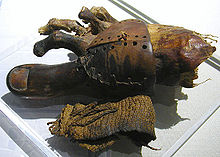

- Bandage – The Ancient Egyptians were the first to use adhesive bandages and were also the first to treat wounds with Honey.[74][75]
- New Kingdom circa 1000 BC.[76]
- Intramedullary rod - The oldest intramedullary nail was found in the left knee of a mummy named Usermontu, the remains of an Egyptian man from more than 3,500 years ago. Researchers believe the pin was inserted after the man's death, but before his burial.[77]
- Cauterization – Cauterization has been used to stop heavy bleeding since antiquity. The process was described in the Edwin Smith Papyrus.[78]
- Toothpaste – Since 5000 BC, the Egyptians made a tooth powder, which consisted of powdered ashes of ox hooves, myrrh, powdered and burnt eggshells, and pumice.[79]
- Breath mint[80]
- papyrus ebers, refers to the use of soft papyrus tampons by Egyptian women in the fifteenth century B.C.[81]
Innovations
- Gynaecology – The Kahun Gynaecological Papyrus, dated to about 1800 BC, deals with women's health gynaecological diseases, fertility, pregnancy, contraception, etc. Treatments are non surgical, comprising applying medicines to the affected body part or swallowing them. The womb is at times seen as the source of complaints manifesting themselves in other body parts.[82]
- Pregnancy test – The ancient Egyptians watered bags of wheat and barley with the urine of a possibly pregnant woman. Germination indicated pregnancy. The type of grain that sprouted was taken as an indicator of the fetus's sex.[83]
- BCE.[87]
- Surgical suture – The earliest reports of surgical suture date to 3000 BC in ancient Egypt, and the oldest known suture is in a mummy from 1100 BC.[88]
- Ophthalmology – In the Ebers Papyrus from ancient Egypt dating to 1550 BC, a section is devoted to eye diseases.[89]
Mathematics
Algebra
- Numeral system – Written evidence of the use of mathematics dates back to at least 3200 BC with the ivory labels found in Tomb U-j at Abydos. These labels appear to have been used as tags for grave goods and some are inscribed with numbers.[90] Further evidence of the use of the base 10 number system can be found on the Narmer Macehead which depicts offerings of 400,000 oxen, 1,422,000 goats and 120,000 prisoners.[91]
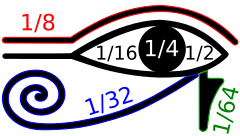
- Binary – The method used for ancient Egyptian multiplication is also closely related to binary numbers. In this method, multiplying one number by a second is performed by a sequence of steps in which a value (initially the first of the two numbers) is either doubled or has the first number added back into it; the order in which these steps are to be performed is given by the binary representation of the second number. This method can be seen in use, for instance, in the Rhind Mathematical Papyrus, which dates to around 1650 BC.[92][93]
- Arithmetics with fractions – The earliest fractions were reciprocals of integers: ancient symbols representing one part of two, one part of three, one part of four, and so on.[94] The Egyptians used Egyptian fractions c. 1000 BC. About 4000 years ago, Egyptians divided with fractions using slightly different methods. They used least common multiples with unit fractions. Their methods gave the same answer as modern methods.[95]
- Akhmim Wooden Tablet and several Rhind Mathematical Papyrus problems.[96]
- X (Unknown)
- Quadratic equation – The ancient Egyptians were the first civilization to develop and solve second-degree (quadratic) equations. This information is found in the Berlin Papyrus fragment. Additionally, the Egyptians solve first-degree algebraic equations found in Rhind Mathematical Papyrus.[97]
- Exponentiation (Power of two) – The ancient Egyptians had laid out tables of a great number of powers of two, rather than recalculating them each time. The decomposition of a number thus consists of finding the powers of two which make it up. The Egyptians knew empirically that a given power of two would only appear once in a number.[98]
- Egyptian mathematics.[99]
- Kahun Papyrus – that shows how the Egyptians extracted square roots by an inverse proportion method.[100]
- 0 – By 1770 BC, the Egyptians had a symbol for zero in accounting texts. The symbol nfr, meaning beautiful, was also used to indicate the base level in drawings of tombs and pyramids and distances were measured relative to the base line as being above or below this line.[101]
|
- The Rhind Papyrus, dated around 1650 BC but copied from a document dated to 1850 BC, has a formula for the area of a circle that treats π as (16/9)2 ≈ 3.16.
- The Golden number[105]
- Arithmetic progression – Rhind Mathematical Papyrus problem number 40.[106]
- Pefsu problem (modern day: Arithmetic mean and Arithmetic progression)[107]
- Geometric mean and Geometric progression - see problem no.79 in Rhind Mathematical Papyrus.[108]
- The Rhind Mathematical Papyrus, from around 1550 BC, has Egyptian fraction expansions of different forms for prime and composite numbers.[109]
- Conversion of units – Rhind Mathematical Papyrus problem number 42.[106]
- Seked (Modern day Slope) – The seked is proportional to the reciprocal of our modern measure of slope or gradient, and to the cotangent of the angle of elevation.[110][111]
- Trigonometry and Trigonometric functions – Rhind Mathematical Papyrus problem number 56. The Egyptians, used a primitive form of trigonometry for building pyramids in the 2nd millennium BC.[112]
Areas and Volumes
- Area of Triangle – Rhind Mathematical Papyrus problem number 51.[106]
- Area of Trapezoid – Rhind Mathematical Papyrus problem number 52.[106]
- Surface area of Sphere – The Tenth problem of the Moscow Mathematical Papyrus asks for a calculation of the surface area of a hemisphere (Struve, Gillings) or possibly the area of a semi-cylinder (Peet). Below we assume that the problem refers to the area of a hemisphere.[115]
- Volume of Cylinder – Rhind Mathematical Papyrus problem number 41.[106]
- Volume of Prism – Rhind Mathematical Papyrus problem number 46.[106]
- Volume of Pyramid
- Volume of Frustum – The 14th problem of the Moscow Mathematical Papyrus calculates the volume of a frustum. Problem 14 states that a pyramid has been truncated in such a way that the top area is a square of length 2 units, the bottom a square of length 4 units, and the height 6 units, as shown. The volume is found to be 56 cubic units, which is correct.[116]
Measurement
- System of measurement and Metrology – Ancient Egypt was one of the first civilization to have system of measurement.[117] The Ancient Egyptian measuring systemcontained measuring units for:

- Palermo stone records grants of land expressed in terms of kha and setat. Mathematical papyri also include units of land area in their problems. For example, several problems in the Moscow Mathematical Papyrus give the area of rectangular plots of land in terms of setat and the ratio of the sides and then require the scribe to solve for their exact lengths.[119]
- Volume[119]
- New Kingdom however it was equivalent to 91 grams. For smaller amounts the qedet (1⁄10 of a deben) and the shematy (1⁄12 of a deben) were used.[120]
- , i.e. the reciprocal of gradients as measured today.
Science
- Geologic map - The oldest known geologic map is the Turin papyrus (1150 BCE), which shows the location of building stone and gold deposits in Egypt.[122][123] it would be another 2900 years before the next geologic map was made and this was in France during the mid-1700's. the Turin Papyrus is also a topographic map and the first relatively modern-looking of its kind.
Astronomy
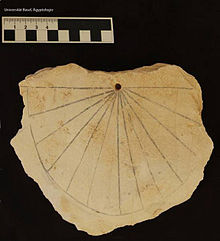
- Decan – Decans are 36 groups of stars (small constellations) used in the Ancient Egyptian astronomy. They rose consecutively on the horizon throughout each Earth rotation. The rising of each decan marked the beginning of a new decanal "hour" (Greek hōra) of the night for the ancient Egyptians, and they were used as a sidereal star clock beginning by at least the 9th or 10th Dynasty (c. 2100 BCE).[124]
- The discovery of Algol – An Ancient Egyptian Calendar of Lucky and Unlucky Days composed some 3,200 years ago is claimed to be the oldest historical document of the discovery of Algol.[125][126][127]
- Sothic cycle
- Calendar[128]
- Star clock[129]
- Solstice and Equinox[130]
- Sundials – The earliest sundials known from the archaeological record are shadow clocks (1500 BC or BCE) from ancient Egyptian astronomy.[131]
Tools and machines
- ancient Egyptians, invented in 3000 BC.[132]
- Papyrus Paper – Papyrus paper was first manufactured in Egypt as far back as the fourth millennium BCE.[133][134][135] The earliest archaeological evidence of papyrus was excavated in 2012 and 2013 at Wadi al-Jarf, an ancient Egyptian harbor located on the Red Sea coast. These documents, the Diary of Merer, date from c. 2560–2550 BCE (end of the reign of Khufu).[134] The papyrus rolls describe the last years of building the Great Pyramid of Giza.[136]
- Lathe - The lathe is an ancient tool. The earliest evidence of a lathe dates back to Ancient Egypt around 1300 BC.[137] There is also tenuous evidence for its existence at a Mycenaean Greek site, dating back as far as the 13th or 14th century BC.[138]
- Herodotus Machine – The Herodotus Machine was a machine described by Herodotus, a Greek historian. Herodotus claims this invention enabled the ancient Egyptians to construct the pyramids. The contraption supposedly allowed workers to lift heavy building materials. Herodotus is believed to have encountered the device while traveling through Egypt. With limited reference and no true schematics, this machine has stimulated many historians' theories of how the Ancient Egyptians were able to create pyramids.[139]
- ancient Egypt technology, workmen used the lever to move and uplift obelisks weighing more than 100 tons. This is evident from the recesses in the large blocks and the handling bosses which could not be used for any purpose other than for levers.[140]
- Loom – Looms were used in ancient Egypt as early as 4400 BC, a foot pedal was used for the earliest horizontal frame loom.[141]
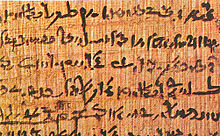
- Pulley – The earliest evidence of pulleys date back to Ancient Egypt in the Twelfth Dynasty (1991–1802 BCE)[142]
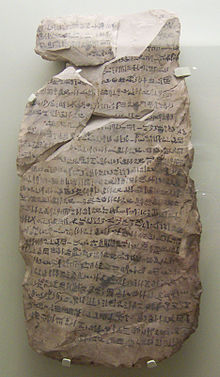
- Razor - Excavations in Egypt have unearthed solid gold and copper razors in tombs dating back to the 4th millennium BC.[143]
- Ptolemaic kingdom.[145]
- Plumb bob – The Plumb bob has been used since at least the time of ancient Egypt[146]
- Tweezers - Tweezers are known to have been used in predynastic Egypt.[147]
- 2650 BC),[148]
- Ink – Ink was used in Ancient Egypt for writing and drawing on papyrus from at least the 26th century BC.[134]
- Siphon – Ancient Egyptian reliefs from 1500 BC depict siphons used to extract liquids from large storage jars.[149][150]
- Egyptian. When visible, the stars could be used to measure the time at night. There were 10 stars for the 10 hours of the night; the day had a total of 24 hours including 12 hours for the day, 1 hour for sunset, and 1 hour for sunrise. Merkhets were used to replace sundials, which were useless during the dark.[152]
- Weighing scale - The oldest attested evidence for the existence of weighing scales dates to the Fourth Dynasty of Egypt, with Deben (unit) balance weights, from the reign of Sneferu (c. 2600 BC) excavated, though earlier usage has been proposed.[156]
- Wig – In Egyptian society men and women commonly had clean shaven or close cropped hair and often wore wigs.[157][158] The ancient Egyptians created the wig to shield shaved, hairless heads from the sun. They also wore the wigs on top of their hair using beeswax and resin to keep the wigs in place. Wealthy Egyptians would wear elaborate wigs and scented cones of animal fat on top of their wigs.[157]
- Ramps and Inclined planes – The Egyptian pyramids were constructed using inclined planes,[159][160][161]

- Ramses II (early thirteenth century BC)."[162]
- Doors and Door Locks[163] – The earliest in records are those represented in the paintings of some ancient Egyptian tombs, in which they are shown as single or double doors, each in a single piece of wood. Doors were once believed to be the literal doorway to the afterlife, and some doors leading to important places included designs of the afterlife. Basic principles of the Pin tumbler lock may date as far back as 2000 BC in Egypt; the lock consisted of a wooden post affixed to the door, and a horizontal bolt that slid into the post. The bolt had vertical openings into which a set of pins fitted. These could be lifted, using a key, to a sufficient height to allow the bolt to move and unlock the door.[164] This wooden lock was one of Egypt's major developments in domestic architecture during classical times.
- Combs[165]
- Bellows – Bellows were used as early as the New Kingdom.[166]
- Hinge - Ancient remains of stone, marble, wood, and bronze hinges have been found. Some date back to at least Ancient Egypt.[167]
- Early Dynastic Period, circa 3,100–2,686 BC.[168][page needed] Many copper saws were found in tomb No. 3471 dating to the reign of Djer in the 31st century BC.[169] Saws have been used for cutting a variety of materials, including humans (death by sawing). Models of saws have been found in many contexts throughout Egyptian history. Particularly useful are tomb wall illustrations of carpenters at work that show sizes and the use of different types. Egyptian saws were at first serrated, hardened copper which cut on both pull and push strokes. As the saw developed, teeth were raked to cut only on the pull stroke and setwith the teeth projecting only on one side, rather than in the modern fashion with an alternating set. Saws were also made of bronze and later iron.
- Air conditioning – The basic concept behind air conditioning is said to have been applied in ancient Egypt, where reeds were hung in windows and were moistened with trickling water. The evaporation of water cooled the air blowing through the window. This process also made the air more humid, which can be beneficial in a dry desert climate.[170]
- Hand fan – Hand fans had been used in Egypt as early as 4,000 years ago. Hand fans have been found in King Tut's tomb.[171]
- Pens and Reed pens – Ancient Egyptians had developed writing on papyrus scrolls when scribes used thin reed brushes or reed pens from the Juncus maritimus or sea rush.[172] In his book A History of Writing, Steven Roger Fischer suggests that on the basis of finds at Saqqara, the reed pen might well have been used for writing on parchment as long ago as the First Dynasty or about 3000 BC.
- Spoon – Preserved examples of various forms of spoons used by the ancient Egyptians include those composed of ivory, flint, slate and wood; many of them carved with religious symbols.[173][174]
- tomb of architect Kha.[177]
- tomb of architect Kha.[177]
- Copper Pipes – The c.2400 BCE, Pyramid of Sahure, and adjoining temple complex at Abusir, was discovered to have a network of copper drainage pipes.[178]
- Archimedes' screw – Although commonly attributed to Archimedes, the device had been used in Ancient Egypt long before his time.[179] The first records of a water screw, or screw pump, date back to Ancient Egypt before the 3rd century BC.[180] The Egyptian screw, used to lift water from the Nile, was composed of tubes wound round a cylinder; as the entire unit rotates, water is lifted within the spiral tube to the higher elevation. A later screw pump design from Egypt had a spiral groove cut on the outside of a solid wooden cylinder and then the cylinder was covered by boards or sheets of metal closely covering the surfaces between the grooves.
- Screw pump – The screw pump is the oldest positive displacement pump.[181] The first records of a water screw, or screw pump, dates back to Ancient Egypt before the 3rd century BC.[180] The Egyptian screw, used to lift water from the Nile, was composed of tubes wound round a cylinder; as the entire unit rotates, water is lifted within the spiral tube to the higher elevation. A later screw pump design from Egypt had a spiral groove cut on the outside of a solid wooden cylinder and then the cylinder was covered by boards or sheets of metal closely covering the surfaces between the grooves.
Furniture
Furniture became common first in Ancient Egypt during the Naqada culture.[182] During that period a wide variety of furniture pieces were invented and used.
- Tables – Some very early tables were made and used by the ancient Egyptians[183] around 2500 BC, using wood and alabaster.[184] They were often little more than stone platforms used to keep objects off the floor, though a few examples of wooden tables have been found in tombs. Food and drinks were usually put on large plates deposed on a pedestal for eating. The Egyptians made use of various small tables and elevated playing boards.
- Early Dynastic Period of Egypt (c. 3100 BC). They were covered with cloth or leather, were made of carved wood, and were much lower than today's chairs – chair seats were sometimes only 10 inches (25 cm) high.[185]
- camp bed - It is believed that King Tut, who reigned in Egypt from approximately 1332 to 1323 BC, may have had the first camping bed. When Tutankhamun's tomb was opened in 1922 a room full of furniture was found to contain a three-section camping bed that folded up into a Z shape.Though the frail young king, who had a clubfoot, may never have taken part in long-distance explorations, the elaborate folding bed suggests he had an interest in camping and hunting.[186]
- Chest (furniture) - The Ancient Egyptians created the first known chests, using wood or woven reeds, circa 3000 BC.[187]
Arts and Architecture
Architecture
- Mastaba – Was a predecessor to the Egyptian pyramid. Kings of the Early Dynastic Period were buried there.
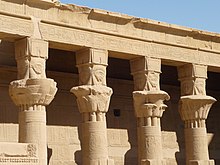
- palm. In later Egyptian architecture faceted cylinders were also common. Their form is thought to derive from archaic reed-built shrines. Carved from stone, the columns were highly decorated with carved and painted hieroglyphs, texts, ritual imagery and natural motifs. Egyptian columns are famously present in the Great Hypostyle Hallof Karnak (circa 1224 BC), where 134 columns are lined up in sixteen rows, with some columns reaching heights of 24 metres.

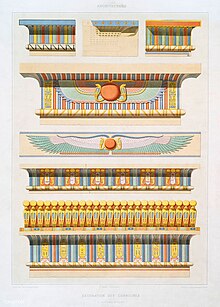
- pleasure gardens, Palace gardens, Temple gardens and Funerary gardens.[191]
- Windcatcher - Windcatchers were used in traditional ancient Egyptian architecture from the very early historical times,[192] and only started to fall out of use in the mid-1900s C.E..
- Cavetto – Ancient Egyptian architecture made special use of large cavetto mouldings as a cornice, with only a short fillet (plain vertical face) above, and a torus moulding (convex semi-circle) below. This cavetto cornice is sometimes also known as an "Egyptian cornice", "hollow and roll" or "gorge cornice", and has been suggested to be a reminiscence in stone architecture of the primitive use of bound bunches of reeds as supports for buildings, the weight of the roof bending their tops out.[193]
- used corbel vaults in some of their chambers.
Crafts
- Wood carving and Wooden statues – The extreme dryness of the climate of Egypt accounts for the existence of a number of woodcarvings from this remote period. Some wood panels from the tomb of Hosul Egypt, at Saqqara are of the Third Dynasty. The carving consists of Egyptian hieroglyphs and figures in low relief, and the style is extremely delicate and fine. A stool shown on one of the panels has the legs shaped like the fore and hind limbs of an animal, a form common in Egypt for thousands of years.
- Hollow Glass Production and Glassware – Egypt and Mesopotamia were the first civilizations to produce glass works(3,500 BC.). The oldest specimens of glass are from Egypt and date back to 2000 B.C. In 1500BC the industry was well established in Egypt.[195]
- Egyptian faience
- Cosmetic palette

- Tutankhamen (c. 1323 BC), the latter a glove and a robe.[196]
- Watercolor paper – Painting on Papyrus was invented in Ancient Egypt long before the invention of Paper.
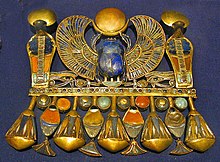
Music and Dance

tomb of Tutankhamun
(1326–1336 BC)- Sistrum – The sistrum was a sacred instrument in ancient Egypt. Perhaps originating in the worship of Bastet, it was used in dances and religious ceremonies, particularly in the worship of the goddess Hathor, with the U-shape of the sistrum's handle and frame seen as resembling the face and horns of the cow goddess.[202]
- hymns today.[203]
- Syllabtic music style – The Syllabtic music style had been used for 2000 years in the coptic church "Tasbe7a".[204]
Literature
- Written records – The Ancient Egyptian sentence found in the tomb of Seth-Peribsen is the world's oldest known sentence[205]

- Short story – short story started in Ancient Egypt around 2000 BC. Among the oldest known stories the "Story of Sinuhe" and the "Tale of the Shipwrecked Sailor".[206]
- Egyptologist Edward Wente (1990) speculates that the Fifth Dynasty Pharaoh Djedkare Isesi (in his many letters sent to his viziers) was a pioneer in the epistolary genre.[207]
- Sebayt and Wisdom literature – The Maxims of Ptahhotep are among the oldest pieces of wisdom literature. It was compiled during the 24th century BC.[208][209]
- Satire - One of the earliest examples of what we might call satire, The Satire of the Trades,[210] is in Egyptian writing from the beginning of the 2nd millennium BC. The text's apparent readers are students, tired of studying. It argues that their lot as scribes is not only useful, but far superior to that of the ordinary man. Scholars such as Helck[211] think that the context was meant to be serious. The Papyrus Anastasi I[212] (late 2nd millennium BC) contains a satirical letter which first praises the virtues of its recipient, but then mocks the reader's meagre knowledge and achievements.
Sports

- Bowling – The earliest known forms of bowling date back to ancient Egypt,[214] with wall drawings depicting bowling being found in a royal Egyptian tomb dated to 5200 B.C.[215] and miniature pins and balls in an Egyptian child's grave about 5200 B.C.[216] Remnants of bowling balls were found among artifacts in ancient Egypt going back to the Egyptian protodynastic period in 3200 BC.[217] What is thought to be a child's game involving porphyry (stone) balls, a miniature trilithon, and nine breccia-veined alabaster vase-shaped figures—thought to resemble the more modern game of skittles—was found in Naqada, Egypt in 1895.[213]
- Hockey – Drawings on tombs at Beni Hassan in Menia Governorate show players holding bats made of long palm-tree branches, with a bent end similar to that of the hockey bat. The hockey ball was made of compressed papyrus fibers covered with two pieces of leather in the shape of a semicircle.[218][219]
- Handball – Drawings of this sport are found on the Saqqara tombs, five thousand years old. The ball was made of leather and stuffed with plant fibers or hay, or made of papyrus plants in order to be light and more durable. It was seldom used for more than one match.[218]
- Weightlifting – Weightlifting was first recorded in ancient Egypt. One method of weightlifting was lifting a heavy sack of sand with one hand and keep it high in a vertical position. The player had to hold that sack of sand for some time and stay in the same position. This rule is still applied in the modern weightlifting.[223][219]
- High jump[219]
- Tug of Hoop[219][225]
- Equilibrium (sport)[219][226]

- 1190 B.C.[227]
- Tahtib – The oldest traces of tahtib were found on engravings from the archaeological site of Abusir, an extensive necropolis of the Old Kingdom period, located in the south-western suburbs of Cairo. On some of the reliefs of the Pyramid of Sahure (V dynasty, c. 2500 BC);[228] the images and explanatory captions are particularly precise and accurate in their depiction of what seems to be military training using sticks. Tahtib, with archery and wrestling, was then among the three disciplines of warfare taught to soldiers.
Cuisine
- Frying – Frying is believed to have first appeared in the ancient Egyptian kitchen, during the Old Kingdom, around 2500 BCE.[229]
- New Kingdom. They usually started sometime in the afternoon. Men and women were separated unless they were married. Seating varied according to social status, with those of the highest status sitting on chairs, those slightly lower sat on stools and those lowest in rank sat on the raw floor. Before the food was served, basins were provided along with aromatics and cones of scented fat were lit to spread pleasant smells or to repel insects, depending on the type.[230]
- Lettuce – Lettuce was first cultivated in ancient Egypt for the production of oil from its seeds. This plant was probably selectively bred by the Egyptians into a plant grown for its edible leaves,[231] with evidence of its cultivation appearing as early as 2680 BC. Lettuce was considered a sacred plant of the reproduction god Min, and it was carried during his festivals and placed near his images. The plant was thought to help the god "perform the sexual act untiringly."[232] Its use in religious ceremonies resulted in the creation of many images in tombs and wall paintings. The cultivated variety appears to have been about 75 cm (30 in) tall and resembled a large version of the modern romaine lettuce. These upright lettuces were developed by the Egyptians and passed to the Greeks, who in turn shared them with the Romans.

- Foie gras and force-feeding – The technique of gavage dates as far back as 2500 BC, when the ancient Egyptians began keeping birds for food and deliberately fattened the birds through force-feeding.[233] Today, France is by far the largest producer and consumer of foie gras, though it is produced and consumed worldwide, particularly in other European nations, the United States, and China.[234]
- Biscuits – versions using various grains date back to Ancient Rome, and as far back as Ancient Egypt.[235]
- Smy – thickened milk[b] documented as existent in ancient Egypt.
- Saqqara necropolis, it is around 3200 years old.[237] Earlier, remains identified as cheese were found in the funeral meal in an Egyptian tomb dating around 2900 BC.[238] Visual evidence of Egyptian cheesemaking was found in Egyptian tomb murals in approximately 2000 BC.[239]
- Yeast – The earliest definite records of yeast come from Ancient Egypt.[240]
- desserts, evidence of which can be found on the tomb walls of the Pharaoh Ramesses II, who ruled from 1304 to 1237 BC, located in the Valley of the Kings.[241]
- Boiled eggs – In Thebes, Egypt, the tomb of Haremhab, dating to approximately 1420 BCE, shows a depiction of a man carrying bowls of ostrich eggs and other large eggs, presumably those of the pelican, as offerings.[242]In ancient Rome, eggs were preserved using a number of methods and meals often started with an egg course.
Clothing and Cosmetics
- palm-leaves or coloured feathers fixed on a long handle, resembling those now carried behind the Popein processions.
- Hairpin – Hairpins made of metal, ivory, bronze, carved wood, etc. were used in ancient Egypt[246] for securing decorated hairstyles. Such hairpins suggest, as graves show, that many were luxury objects among the Egyptians and later the Greeks, Etruscans, and Romans.
- Shirt – The world's oldest preserved garment, discovered by Flinders Petrie, is a "highly sophisticated" linen shirt from a First Dynasty Egyptian tomb at Tarkan, dated to c. 3000 BC: "the shoulders and sleeves have been finely pleated to give form-fitting trimness while allowing the wearer room to move. The small fringe formed during weaving along one edge of the cloth has been placed by the designer to decorate the neck opening and side seam."[247]
- Quilting - The earliest known quilted garment is depicted on the carved ivory figure of a Pharaoh dating from the ancient Egyptian First Dynasty (c. 3400 BC).[248]
- Makeup - The origin of cosmetics such as Rouge, Eye shadow, etc. dates back to pre dynastic Egypt.[249]
- Kohl[250]
- Liniment – made from Castor oil.[250]
- Hair dye – Ancient Egyptian, Ahmose-Henuttamehu (17th Dynasty, 1574 BCE): was probably a daughter of Seqenenre Tao and Ahmose Inhapy. Smith reports that the mummy of Henuttamehu's own hair had been dyed a bright red at the sides, probably with henna.[251]
- High-heeled shoe – Paintings circa 3,500 BC. show images of men and women wearing high-heeled shoes. High-heeled shoes was also used by butchers to make them move easily over the dead animals.[252]
- Flip-flops - Thong sandals have been worn for thousands of years, dating back to pictures of them in ancient Egyptian murals from 4,000 BC. Ancient Egyptian sandals were made from papyrus and palm leaves.[253]
- Greco-Roman times, around 2,300 years ago.[254]
- Gloves[255]
- Perfume – The evidence of the first perfumes date to ancient Egypt, Mesopotamia, and Cyprus.[256]
Others
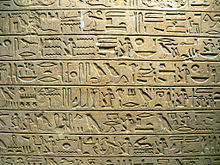
- Umm el-Qa'ab) in 1998 or the Narmer Palette (c. 31st century BC).[257]
- Hieratic – Hieratic developed as a cursive form of hieroglyphic script in the Naqada III period, roughly 3200–3000 BCE.[258]
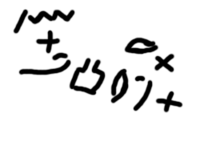
- Sinai peninsula dated to circa the 15th century BC, apparently left by Canaanite workers. In 1999, John and Deborah Darnell discovered an even earlier version of this first alphabet at Wadi el-Hol dated to circa 1800 BC and showing evidence of having been adapted from specific forms of Egyptian hieroglyphs that could be dated to circa 2000 BC, strongly suggesting that the first alphabet had been developed about that time.[261] Based on letter appearances and names, it is believed to be based on Egyptian hieroglyphs.[262]This script had no characters representing vowels, although originally it probably was a syllabary, but unneeded symbols were discarded.
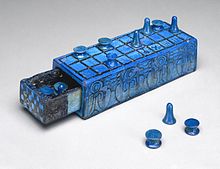
- Mehen – Evidence of the game of Mehen is found from the Predynastic period dating from approximately 3000 BC and continues until the end of the Old Kingdom, around 2300 BC.[266]
- Writing - writing first arose in Egypt around 3300 BC, contemporaneous with Mesopotamia or may predate it.[267][268][269]
- Monotheism - The earliest known instance of monotheism appeared in 14th century BC Egypt during the reign of Akhenaten.[270]
- School - Perhaps the earliest formal school was developed in Egypt's Middle Kingdom under the direction of Kheti, treasurer to Mentuhotep II (2061-2010 BC).[271]
- Sick leave – Already in 1500 BCE, at least some of the workers who built the tombs of Egyptian pharaohs received paid sick leave as well as state-supported health care.[272]
- Strike action – The first historically certain account of strike action was towards the end of the 20th Dynasty, under Pharaoh Ramses III in ancient Egypt on 14 November in 1152 BC. The artisans of the Royal Necropolis at Deir el-Medina walked off their jobs because they had not been paid.[273][274]
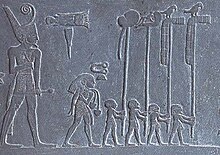
- Vexilloid - The oldest known vexilloids appear as depictions on Egyptian pottery from the Gerzeh culture and on the reverse of the Narmer Palette. These vexilloids were symbols of the nomes of pre-dynastic Egypt.[275]
- Sarcophagus - The earliest stone sarcophagi were used by Egyptian pharaohs of the 3rd dynasty, which reigned from about 2686 to 2613 B.C.[276]
- Fifth Dynasty (approx 2392–2283 BCE) and noted significant events in each year of their reigns. It was probably made during the Fifth Dynasty.[278]These inscriptions are considered as the oldest History studies.
- 4th Dynasty. They are the oldest known papyri with text. The text was found in 2013 by a French mission under the direction of archaeologists Pierre Tallet of Paris-Sorbonne University and Gregory Marouard in a cave in Wadi al-Jarf on the Red Sea coast.[279][280][281][282]
- Tobacco pipe[283][284]
- cats were used to control pests of grain stores such as rodents.[285][286] Mongooses were introduced into homes to control rodents and snakes, probably by the ancient Egyptians.[287]

Graeco-Roman Egypt
Hero of Alexandria[290][291][292][293]

- method for iteratively computing the square root of a number.[294]Today, however, his name is most closely associated with Heron's formula for finding the area of a triangle from its side lengths.
- He also devised a method for calculating cube roots in the 1st century AD.[295] He also designed a shortest path algorithm, Given two points A and B on one side of a line, find C a point on the straight line, that minimizes AC+BC.
- Vending machine – The first vending machine was also one of his constructions; when a coin was introduced via a slot on the top of the machine, a set amount of holy water was dispensed. This was included in his list of inventions in his book Mechanics and Optics. When the coin was deposited, it fell upon a pan attached to a lever. The lever opened up a valve which let some water flow out. The pan continued to tilt with the weight of the coin until it fell off, at which point a counter-weight would snap the lever back up and turn off the valve.[296]
- Heron's fountain – A standalone fountain that operates under self-contained hydro-static energy; now called Heron's fountain.[297]
- In optics, Hero formulated the Alhacen expanded the principle to both reflection and refraction, and the principle was later stated in this form by Pierre de Fermat in 1662; the most modern form is that the optical path is stationary.
- A wind-wheel operating an organ, marking the first instance in history of wind powering a machine.[299][300]
- Hero also invented many mechanisms for the Greek
- A programmable cart that was powered by a falling weight. The "program" consisted of strings wrapped around the drive axle.[301]
- Heron of Alexandria in Roman Egypt invented the first known automatic door. He described two different automatic door applications. The first application used heat from a fire lit by the city's temple priest. After a few hours atmospheric pressure built up in a brass vessel causing it to pump water into adjacent containers. These containers acted as weights that, through a series of ropes and pulleys, would open the temple's doors at about the time people were to arrive for prayer. Heron used a similar application to open the gates to the city.[302]
Pappus of Alexandria
Ptolemy
- lapsing into obscurity. The idea of a global coordinate system revolutionized European geographical thought, however, and inspired more mathematical treatment of cartography.[303]
- Ptolemy was the first to measure the
- Ptolemy's intense diatonic scale – Ptolemy's intense diatonic scale is a tuning for the diatonic scale proposed by Ptolemy,[306] declared by Zarlino to be the only tuning that could be reasonably sung, and corresponding with modern just intonation.[307] It is also supported by Giuseppe Tartini.[308]
- Ptolemy's contribution to the science of Trigonometry are many, among them a theorem that was central to Ptolemy's calculation of chords was what is still known today as Ptolemy's theorem, that the sum of the products of the opposite sides of a cyclic quadrilateral is equal to the product of the diagonals. A special case of Ptolemy's theorem appeared as proposition 93 in Euclid's Data. Ptolemy's theorem leads to the equivalent of the four sum-and-difference formulas for sine and cosine that are today known as Ptolemy's formulas, although Ptolemy himself used chords instead of sine and cosine.[309] Ptolemy further derived the equivalent of the half-angle formula
- .
Others
Victoria and Albert museum
, reference 2085&A-1900.- Saqiyah – Paddle-driven water-lifting wheels had appeared in ancient Egypt by the 4th century BCE.[310] According to John Peter Oleson, both the compartmented wheel and the hydraulic noria appeared in Egypt by the 4th century BCE, with the sakia being invented there a century later. This is supported by archeological finds at Faiyum, where the oldest archeological evidence of a water wheel has been found, in the form of a sakia dating back to the 3rd century BCE. A papyrus dating to the 2nd century BCE also found in Faiyum mentions a water wheel used for irrigation, a 2nd-century BC fresco found at Alexandria depicts a compartmented sakia, and the writings of Callixenus of Rhodes mention the use of a sakia in the Ptolemaic Kingdom during the reign of Ptolemy IV Philopator in the late 3rd century BCE.[311]
- Fifteen centuries before Braille, wood-carving techniques were in use in the Catechical school of Alexandria by blind scholars to read and write.[312][313]
Religion
- Catechesis – The oldest Catechical school in the world is the catechical school of Alexandria.[314]
- Saint Pachomius, although in a stricter form.
Islamic Egypt
- caliph Al-Mu'izz li-Din Allah in Egypt demanded a pen that would not stain his hands or clothes, and was provided with a pen that held ink in a reservoir, allowing it to be held upside-down without leaking.[315]
- Sugar refinery – Date back to the 12th century in Medieval Egypt.[317]
- coefficients to equations.[318]
- Da'irah al-Mu'addal – An astronomical device invented by the Egyptian scientist 'Abd al-'Aziz al-Wafa'i.[319]
- In the late 10th and early 11th centuries AD, the Egyptian astronomer trigonometric identity:[320]
- The astrolabic quadrant was invented in Egypt in the 11th century or 12th century, and later known in Europe as the "Quadrans Vetus" (Old Quadrant).[321]
Modern Egypt
Metal–oxide–semiconductor field-effect transistor
(MOSFET)

- Cancer treatment with gold – This discovery was made by the Egyptian scientist Mostafa El-Sayed.[322]
- Metal–oxide–semiconductor field-effect transistor (MOSFET) – Invented by Egyptian engineer Mohamed M. Atalla with Dawon Kahng at Bell Labs in 1959 and demonstrated in 1960.[323][324]
- CDMA applications, the main technology currently used by many cellphone networks. The works of Hatim Zaghloul and WiLAN contributed to the invention of Wi-Fi, 3G technology and 4Gtechnology.
- Sameera Moussa developed an equation that would allow the atoms of cheap metals (e.g. Copper) to be split and radiate nuclear radiations.[328]
- ultrafast laser technique (consisting of ultrashort laser flashes), the technique allows the description of reactions on very short time scales – short enough to analyse transition states in selected chemical reactions.[332] Zewail became known as the "father of femtochemistry".[333]
- Mohamed Lotfy(grandfather of Taimour Lotfy) for the training of beginner tennis players. Today it is a sport in its own right, enjoying popularity not only in Egypt but in other countries. Several of these countries make up the International Federation of Speed-Ball (FISB).
- The PWCT visual programming language[334][335] and the Ring dynamic programming language[336] are invented by Egyptian engineer Mahmoud Samir Fayed.[337] He started creating PWCT in 2005 at the Faculty of Electronic Engineering, Egypt.[338] He developed Ring while being a researcher at King Saud University.[339][340]
- Mansourasaurus – Hesham Sallam, a paleontologist at Mansoura University, together with a team of students discovered a sauropod skeleton in the Dakhla Oasis in Egypt's Western Desert.[341] In 2016, it was reported that over thirty dinosaur specimens had been excavated, among them titanosaurian sauropods.[342]
Notes
References
- .
- ^ Gascoigne, Bamber. "Historyworld". History of Banking. Retrieved 1 March 2014.
- ISBN 978-0-7637-8352-5.
- JSTOR j.ctt21c4td4.10.
- ^ Théodoridés. "law". Encyclopedia of the Archaeology of Ancient Egypt.
- ^ VerSteeg, Law in ancient Egypt
- ISBN 978-0-19-993539-0. Retrieved 3 January 2020.
- ISBN 9780471743583.
- ^ Trevor N. Dupuy, Evolution of Weapons and Warfare.
- ^ ISBN 978-1146066846.
- ^ "7.10 Egyptian Forts in Nubia and Indigenous Peoples There". worldhistory.biz. 8 May 2015. Retrieved 23 September 2018.
- ^ "Siege warfare in ancient Egypt". Tour Egypt. Archived from the original on 11 February 2019. Retrieved 23 May 2020.
...we find a pair of Middle Kingdom soldiers advancing towards a fortress under the protection of a mobile roofed structure. They carry a long pole that was perhaps an early battering ram.
- ISBN 978-1-5040-6059-2.
- ^ "Britannica: Ram".
- ISBN 978-0199797455.
- Cyril John Gadd, Nicholas Geoffrey Lemprière Hammond, 1970
- ^ "Dogs of War in European Conflict; Egyptians and Romans Employed Them in Early Warfare – Battle Dogs in 4000 B.C". The New York Times. 21 February 1915. p. S3. Retrieved 26 November 2008.
- ^ "History of Cryptography". Binance Academy. Archived from the original on 26 April 2020. Retrieved 2 April 2020.
- ^ Günther Garbrecht: "Wasserspeicher (Talsperren) in der Antike", Antike Welt, 2nd special edition: Antiker Wasserbau (1986), pp.51–64 (52f.)
- ISBN 978-0-19-518731-1.
- ^ Crane, Eva (1984). "Honeybees". In Mason, I. L. (ed.). Evolution of Domesticated Animals. Longman. pp. 403–415.
- ^ Egyptian honeybee Ark of taste
- ^ Bodenheimer, F. S. (1960). Animal and Man in Bible Lands. Brill Archive. p. 79.
- ^ "Oldest horse stables". Guinness World Records. Retrieved 27 June 2016.
- ^ Rose, Mark (2010). "World's First Zoo – Hierakonpolis, Egypt,". Archaeology Magazine. Vol. 63, no. 1.
- S2CID 84992505.
- ^ To Elaiodentro. (Olive Tree), vol I
- ^ "10 Amazing Ancient Egyptian Inventions". 12 January 2011.
- ^ Ward, Cheryl. "World's Oldest Planked Boats," in Archaeology (Volume 54, Number 3, May/June 2001). Archaeological Institute of America. Archaeology.org
- ^ "sail". Britannica. Retrieved 28 March 2022.
- ^ Encyclopedia Of International Sports Studies. Page 31
- ^ Boyle, Alan (15 April 2013). "4,500-year-old harbor structures and papyrus texts unearthed in Egypt". NBC.
- Egyptian Archaeology. 40: 40–43. Retrieved 18 April 2013.
- ISSN 2049-5021. Retrieved 21 April 2013.
- ^ Vinson, Steve. 1994. Egyptian boats and ships. Osprey Publishing.
- ^ a b William F. Edgerton: "Ancient Egyptian Steering Gear", The American Journal of Semitic Languages and Literatures, Vol. 43, No. 4. (1927), pp. 255
- ^ William F. Edgerton: "Ancient Egyptian Steering Gear", The American Journal of Semitic Languages and Literatures, Vol. 43, No. 4. (1927), pp. 257
- ^ William F. Edgerton: "Ancient Egyptian Steering Gear", The American Journal of Semitic Languages and Literatures, Vol. 43, No. 4. (1927), pp. 260
- ISBN 978-977-424-504-6, p.92f.
- ^ Mohamed Ata: "Egypt from Past to Present. Through the Eyes of an Egyptian", Cairo 2007, p.68
- Herodot: Histories, 2.96
- ^ William F. Edgerton: "Ancient Egyptian Steering Gear", The American Journal of Semitic Languages and Literatures, Vol. 43, No. 4. (1927), pp. 263
- ^ Wilford, John Noble (8 May 1994). "World's Oldest Paved Road Found in Egypt – The New York Times". The New York Times. Retrieved 29 August 2018.
- ^ "Lake Moeris Quarry Road".
- ^ "Egypt's Widan Al-Faras:The world's oldest road all but forgotten".
- Environment Canada, Federal Government of Canada. 2004. Archived from the originalon 15 January 2007. Retrieved 27 March 2008.
- ^ "Egyptian civilization – Religion – Mummification".
- ^ "The Chemistry of Mummification". 27 October 2016.
- ^ "History of Turquoise, from Egypt to Native Americans".
- ISBN 978-0-521-45257-1.
- ]
- (PDF) from the original on 7 August 2011.
- ^ "Emerald History and Lore".
- ISBN 1-141-06174-0.
- ^ Susarla, S.M (2016). "The colourful history of malachite green: from ancient Egypt to modern surgery". International Journal of Oral and Maxillofacial Surgery.
- ^ Baker 2008, pp. 343–345.
- ^ Wicker 1998, p. 155.
- ^ ISBN 978-1-879284-09-8.
- ISBN 978-0-930405-53-3.
- ISBN 978-3540222255.
- ISBN 978-0-00-215173-3.
- PMID 24970660.
- PMID 19251160.
- S2CID 39667103.
- ISBN 978-1-4398-2759-8. Archivedfrom the original on 3 April 2016.
- ^ Roberts, Jacob (2015). "Sickening sweet". Distillations. Vol. 1, no. 4. pp. 12–15. Retrieved 20 March 2018.
- ISBN 978-0-387-09840-1. Archivedfrom the original on 4 April 2016.
- LCCN 99039417. Archived from the originalon 14 June 2015. Retrieved 19 June 2020.
- ^ Fairley, Miki (April 2008). "Innovative Crutch Designs: More Gain, Much Less Pain". The O&P Edge.
- ^ Vyse, Stuart (8 May 2019). "In Praise Of The Crutch-Makers". Skeptical Inquirer. Retrieved 8 September 2019.
- ^ ISBN 978-0-691-60561-6.
- PMID 19617021.
- PMID 5322341. From the title (text not accessed).
- ^ ISBN 978-0-19-518765-6.
- PMID 24525756.
- ^ "No. 1705: A 3000-Year-Old Toe". Uh.edu. 1 August 2004. Retrieved 13 March 2013.
- ^ Snow, Karen (June 1996). "BYU professor finds evidence of advanced surgery in ancient mummy". BYU Magazine. Brigham Young University. Retrieved 27 May 2015.
- PMID 8795503.
- ^ "From Eggshells to NASA – The Fascinating History of Toothpaste". 30 March 2017.
- ^ "10 Amazing Ancient Egyptian Inventions". 12 January 2011.
- ^ Who invented tampons? 6 June 2006, The Straight Dope
- ^ Laurinda S. Dixon. Perilous Chastity: Women and Illness in Pre-Enlightenment Art and Medicine, Cornell University Press 1995, pp.15f.
- PMID 13960613.
- ISBN 978-1-4129-6846-1.
- ISBN 978-0-19-928564-8.
- ISBN 978-3-642-21837-8.
- ISBN 978-1-4557-1052-2.
- ^ Suture manual (PDF). p. 4.
- ^ "History of Ophthalmology". www.mrcophth.com.
- S2CID 122060653.
- ISBN 978-0-07-305189-5.
- ISBN 9781615921768.
- ISBN 9780521878180.
- ISBN 978-0-03-029558-4.
- ^ Milo Gardner (19 December 2005). "Math History". Archived from the original on 19 December 2005. Retrieved 18 January 2006. See for examples and an explanation.
- doi:10.1119/1.11512.
- ISBN 1884123007.
- ^ "Egyptian Multiplication".
- ^ Jean-Luc Chabert, ed., A History of Algorithms: From the Pebble to the Microchip (Berlin: Springer, 1999), pp. 86–91.
- ^ Anglin, W.S. (1994). Mathematics: A Concise History and Philosophy. New York: Springer-Verlag.
- ISBN 978-0-691-13526-7.
- ^
Karpinski, Louis C. (1917). "Algebraical Developments Among the Egyptians and Babylonians". MR 1518824.
- ^ Petrie, W.M.F. Wisdom of the Egyptians (1940)
- ISBN 0-8021-3935-3
- ^ "Phi, Pi and the Great Pyramid of Giza". 18 August 2012.
- ^ ISBN 0-87353-133-7.
- ISBN 0-87169-232-5.
- ^ "Collections: Egyptian, Classical, Ancient Near Eastern Art: Fragments of Rhind Mathematical Papyrus". Brooklyn Museum. Retrieved 1 November 2012.
- S2CID 121046003.
- ^ Gillings: Mathematics in the Time of the Pharaohs 1982: pp 212
- ^ Gillings: Mathematics in the Time of the Pharaohs 1982: pp 212
- ISBN 978-0-691-09541-7.
- OCLC 301431218.
- OCLC 313400062.
- ^ Williams, Scott W. Egyptian Mathematical Papyri
- ISBN 0-87169-232-5
- ^ "History of Metrology". Measurement Science Conference. 17 June 2016. Archived from the original on 1 March 2017. Retrieved 28 February 2017.
- ISBN 0486264858.
- ^ ISBN 978-0-87169-232-0.
- ISBN 0262070456.
- Diogenes Laërtius, "Life of Thales", The Lives and Opinions of Eminent Philosophers, I, 27, retrieved 22 February 2008
- S2CID 140154575.
- ISBN 9783642225079.
- ^ Symons, S. L., Cockcroft, R., Bettencourt, J. and Koykka, C. (2013). Ancient Egyptian Astronomy [Online database] Diagonal Star Tables
- S2CID 162969143.
- S2CID 119191453.
- PMID 26679699.
- ^ Clagett (1995), p. 28.
- ^ "Ancient Egyptian Star Clocks and Their Theory".
- ^ "Who Discovered The Solstice First". 20 June 2016.
- ^ "The oldest surviving sundial". Archived from the original on 11 April 2021. Retrieved 28 December 2020.
- ISBN 978-0-8493-4316-2.
- ^ Houston, Keith, The Book: A Cover-to-Cover Exploration of the Most Powerful Object of our Time, W. W. Norton & Company, 2016, pp.4–8 excerpt [1]
- ^ ISSN 2049-5021. Retrieved 21 April 2013.
- ^ H. Idris Bell and T.C. Skeat, 1935. "Papyrus and its uses" (British Museum pamphlet). Archived 18 October 2013 at the Wayback Machine
- ^ Stille, Alexander. "The World's Oldest Papyrus and What It Can Tell Us About the Great Pyramids". Retrieved 27 September 2015.
- ^ "What is a Lathe Machine? History, Parts, and Operation". Brighthub Engineering. 12 December 2009. Retrieved 26 March 2018.
- ^ Clifford, Brian. "A brief history of woodturning". The Woodturner's Workshop. Woodturners' Guild of Ontario. Retrieved 24 July 2018.
- ^ Herodotus, Robin Waterfield, and Carolyn Dewald. The Histories. Oxford: Oxford UP, 2008. Print.
- ISBN 9780486264851.
- ISBN 9780787602567.
4400 B.C. Earliest evidence of the use of a horizontal loom is its depiction on a pottery dish found in Egypt and dated to this time. These first true frame looms are equipped with foot pedals to lift the warp threads, leaving the weaver's hands free to pass and beat the weft thread.
- ISBN 9780195113747.
- ^ razor
- ISBN 9780470901601.
- ISBN 9783319001371.
- ISBN 978-0-415-30664-5. p. 180.
- ISBN 978-0-8196-0123-0.
- ^ Battiscombe Gunn (1926). "AN ARCHITECT'S DIAGRAM OF THE 3RD DYNASTY". Retrieved 30 April 2016.
- ^ "Winemaking in Ancient Egypt: 2000 Years Before the Birth of Christ" (PDF). moundtop.com. Retrieved 30 March 2024.
- ISBN 978-0-4862-5593-4. Retrieved 15 April 2018 – via Google Books.
- ^ Grimal & Shaw 1992, p. 112.
- ^ Whitrow 1989, p. 28.
- OCLC 18520966., pp. 59–61
- ^ Cotterell & Kamminga 1990, pp. 59–61
- ISBN 0-226-15555-2.
- ISBN 978-88-85914-44-5.
- ^ ISBN 9780684805948.
- .
- ^ Thomas, Burke (2005). "Transport and the Inclined Plane". Construction of the Giza Pyramids. world-mysteries.com. Archived from the original on 13 March 2012. Retrieved 10 March 2012.
- ISBN 978-0-8061-3342-3.
- ISBN 978-0-88029-456-0.
- ^ David Diringer, The Book before Printing: Ancient, Medieval and Oriental, Dover Publications, New York 1982, p. 172.
- ^ "10 Amazing Ancient Egyptian Inventions". 12 January 2011.
- ISBN 9780070516458.
- ^ "Ancient Egyptian Inventions".
- ^ John Gardiner Wilkinson (1837). The Manners and Customs of the Ancient Egyptians / Volume 3. p. 338.
- ^ "Door Hinges in Antiquity (Smith's Dictionary, 1875)". Retrieved 19 April 2022.
- ^ Walter B. Emery Excavations at Saqqara, The Tomb of Hemaka and Hor-Aha, Cairo, Government Press, Bulâq, 1938 (2 vols)
- ^ "The 1st Dynasty Tombs of Saqqara in Egypt". Archived from the original on 25 February 2016. Retrieved 15 January 2016. The 1st Dynasty Tombs of Saqqara in Egypt by John Watson
- ^ "Who invented air conditioning". 26 January 2017.
- ^ "A Brief History of Hand Fan".
- ^ Egyptian reed pen Archived 2007-02-21 at the Wayback Machine Retrieved 16 March 2007.
- ^ Chisholm, Hugh, ed. (1911). . Encyclopædia Britannica. Vol. 25 (11th ed.). Cambridge University Press. p. 733.
- ^ "History of Chopsticks, Forks, Spoon and Sporks – Who Invented The Spoon? – Who Invented The Forks?". 8 January 2016.
- ^ "Who Invented The Scissors".
- ^ "The History of Scissors".
- ^ a b "Egyptians May Have Invented The World's First Protractor". 29 July 2011.
- ISBN 978-1-4381-0997-8.
- ISBN 9780873921831. Retrieved 30 April 2020.
The Archimedes' screw was developed in ancient Egypt and was subsequently used by Archimedes (287–212 b.c.)
- ^ a b "Screw". Encyclopædia Britannica online. The Encyclopaedia Britannica Co. 2011. Retrieved 24 March 2011.
- ISBN 0-8247-0948-9.
- ISBN 9780870999079.
- ^ "Ancient Egyptian Furniture: History & Design - Video & Lesson Transcript".
- ISBN 978-0276445699.
- ^ "Furniture". Ancient Egyptian Furniture. Archived from the original on 21 October 2008. Retrieved 13 May 2012.
- ^ King Tut's camp bed
- ISBN 978-0276445699.
- ^ Toby Wilkinson, The Thames and Hudson Dictionary of Ancient Egypt, Thames & Hudson, 2005. p.195
- ^ "NOVA Online | Mysteries of the Nile | A World of Obelisks: Cairo". Pbs.org. Retrieved 14 June 2013.
- ^ Griffith, Francis Llewellyn (1911). . In Chisholm, Hugh (ed.). Encyclopædia Britannica. Vol. 19 (11th ed.). Cambridge University Press. p. 945.
- ^ Descroches-Noblecourt, L'Art Egyptien, pg. 113
- ^ "Air-conditioning avoidance" (PDF). Archived from the original (PDF) on 23 October 2007.
- ISBN 0313353069, 9780313353062, google books
- S2CID 112648240.
- ^ "About Glass Inventors – Who Invented Glass". www.historyofglass.com. Retrieved 26 March 2018.
- ^ Britannica, "Tapestry"
- ^ Lorelei H. Corcoran, "The Color Blue as an 'Animator' in Ancient Egyptian Art", in Rachael B.Goldman, (ed.), Essays in Global Color History: Interpreting the Ancient Spectrum (New Jersey: Gorgias Press, 2016), pp. 59–82.
- ISBN 0-691-02386-7.
- PMID 17173142.
- .
- PMID 34050218.
- ^ Hart (2005), p. 65
- ^ George Kyrillos. Russian Orthodox Encyclopedia vol.37 – The Musicality of Coptic Hymns (PDF). p. 5.
- ^ George Kyrillos. Russian Orthodox Encyclopedia vol.37 – The Musicality of Coptic Hymns (PDF). p. 13.
- ISBN 978-1-107-66467-8.
- ^ "Britannica: short story". Encyclopedia Britannica.
- ISBN 978-1555404734.
- S2CID 59261427.
- ^ "Britannica: Proverbs".
- ^ Lichtheim, M (1973), Ancient Egyptian Literature, vol. I, pp. 184–93
- ^ Helck, W (1970), Die Lehre des DwA-xtjj, Wiesbaden
- ^ Gardiner, Alan H (1911), Egyptian Hieratic Texts, I: Literary Texts of the New Kingdom, vol. I, Leipzig: J. C. Hinrichs’sche Buchhandlung
- ^ a b Petrie, William Matthew; Quibell, James Edward (1896). "VII. Games". Naqada and Ballas, 1895. London: B. Quaritch. p. 35. Cornell University Library. (archeologist's drawing)
- ^ "Bowling History – Origin of Bowling". Retrieved 24 January 2016.
- ^ Luna, Richard (2 June 1984). "Bruce Pluckhahn says there's a little bit of bowling..." United Press International. Archived from the original on 17 April 2019. Statement by Bowling Museum curator Bruce Pluckhahn.
- ^ Kaplan, Jim (7 April 1986). "Here's a Memory Lane for Bowling Fanatics Who Have Some Spare Time". Sports Illustrated. Archived from the original on 8 May 2019.
- ^ Pretsell, James M. (1908). The Game of Bowls Past and Present. Oliver & Boyd. p. 1.
- ^ a b "Ancient Egyptian Sport – SIS".
- ^ a b c d e f "Egyptian Olympic Committee".
- ^ "Ancient Egyptian Sports: Rhythmic Gymnastics".
- ^ "Ancient Egyptian Sports: Consecutive Vault".
- ^ "Ancient Egyptian Sports: Gymnastics".
- ^ "Ancient Egyptian Sports: Weightlifting".
- ^ "Ancient Egyptian Sports: Tug of War".
- ^ "Ancient Egyptian Sports: Tug of Hoop".
- ^ "Ancient Egyptian Sports: Equilibrium".
- ISBN 0271010193[Retrieved 2015-07-12]
- ^ T. El Awady, ibid, VI.6.2, p. 208-210 ; D. Farout, Tahtib l'art de l'accomplissement et du bâton, ةgypte Afrique & Orient n° 60 (janvier 2011), p. 67-69.
- ^ Tannahill, Reay. (1995). Food in History. Three Rivers Press. p. 75
- ^ Encyclopedia of Ancient Egypt; banquets
- ^ Katz and Weaver, pp. 375–376.
- ISBN 1-134-28424-1.
- ^ "Ancient Egypt: Farmed and domesticated animals". Archived from the original on 16 December 2017. Retrieved 10 April 2009.
- ^ "A Global Taste Test of Foie Gras and Truffles". NPR.
- ^ "Education Resource Portal: Hardtack". mnhs.org. Minnesota Historical Society. Retrieved 11 June 2020.
- ISBN 978-0-12-203402-2. Retrieved 19 May 2016.
- ^ "Ancient Egypt: Cheese discovered in 3,200-year-old tomb". BBC News. 18 August 2018. Retrieved 20 August 2018.
- ^ Walter Bryan Emery: A Funerary Repast in an Egyptian Tomb of the Archaic Period. Nederlands instituut voor het Nabije Oosten, Leiden 1962
- ^ History of Cheese. [2] Archived 21 July 2017 at the Wayback Machine. Retrieved10 June 2007.
- ^ "The History of Bread Yeast". BBC. Retrieved 24 December 2006.
- ^ "History of Pies". 19 May 2015.
- ISBN 978-0-8018-5740-9.
- ^ "Marshmallow History-Boyer Candy".
- ^ "Campfire". 27 January 2015.
- ^ White Muscarella, Oscar (1999): "Parasols in the Ancient Near East", "Source: Notes in the History of Art", Vol. 18, No. 2, pp. 1–7 (1)
- .
- ISBN 0-393-31348-4
- ^ Solis-Cohen, Lita; Solis-Cohen, Sally (9 May 1993). "Quilting's story started with the pharaohs". The Baltimore Sun.
- ^ "Why Did We Start Wearing Makeup?". Encyclopaedia Britannica.
- ^ a b Schneider, Günther et al (2005). "Skin Cosmetics" in Ullmann's Encyclopedia of Industrial Chemistry, Wiley-VCH, Weinheim
- ^ G. Elliott Smith, The Royal Mummies, Duckworth Publishing; (September, 2000)
- ^ "Who Invented High Heels".
- ^ Kippen, Cameron (1999). The History of Footwear. Perth, Australia: Department of Podiatry, Curtin University of Technology.
- doi:10.1016/j.jas.2011.08.004. *Jo Marchant (19 August 2011). "Ancient Egyptians used 'hair gel'". Nature News.
- ^ "History of Gloves in Fashion and society". 3 September 2020.
- ^ "The Long History of Perfume".
- S2CID 160704269. Archived from the originalon 19 November 2018. Retrieved 17 June 2020.
- ^ Friedhelm Hoffmann (2012), Hieratic And Demotic Literature, OUP.
- ^ Lynn, Bernadette (8 April 2004). "The Development of the Western Alphabet". h2g2. BBC. Retrieved 4 August 2008.
- ^ Daniels & Bright 1996, pp. 74–75
- JSTOR 3768583.
- ^ Coulmas 1989, pp. 140–141
- ^ Piccione, Peter A. (July–August 1980). "In Search of the Meaning of Senet" (PDF). Archaeology: 55–58. Retrieved 14 July 2018.
- ^ "Okno do svita deskovych her". Hrejsi.cz. 27 April 1998. Archived from the original on 8 December 2012. Retrieved 12 February 2010.
- ^ Pivotto, Carlos; et al. "Detection of Negotiation Profile and Guidance to more Collaborative Approaches through Negotiation Games" (PDF). Retrieved 2 October 2014.
- ISBN 978-1-4742-2117-7.
- ^ "The world's earliest known writing systems emerged at more or less the same time, around 3300 bc, in Egypt and Mesopotamia (today's Iraq)."Teeter, Emily (2011). Before the Pyramids: The Origins of Egyptian Civilization. Oriental Institute of the University of Chicago. p. 99.
- ISBN 9781139486354.
- ISBN 9780521838610.
- ^ "monotheism summary". Encyclopaedia Britannica.
- ^ Marie Parsons. "Education in Ancient Egypt". Tour Egypt.
- ^ Anne Austin (17 February 2015). "Even the ancient Egyptians had paid sick days". Washington Post. Archived from the original on 1 April 2019. Retrieved 8 September 2015.
- ^ François Daumas, (1969). Ägyptische Kultur im Zeitalter der Pharaonen, pp. 309. Knaur Verlag, Munich
- ^ John Romer, Ancient Lives; the story of the Pharaoh's Tombmakers. London: Phoenix Press, 1984, pp. 116–123 See also E.F. Wente, "A letter of complaint to the Vizier To", in Journal of Near Eastern Studies, 20, 1961 and W.F. Edgerton, "The strikes in Ramses III's Twenty-ninth year", Journal of Near Eastern Studies, 10, 1951.
- ISBN 978-1-4351-1838-6.
- ^ "sarcophagus". Britannica. 29 September 2023.
- ^ Günter Dreyer: Ein Siegel der frühzeitlichen Königsnekropole von Abydos, in: MDAIK 43 (1986). 33–43
- ISBN 0-500-05128-3.
- ^ "4,500-year-old harbor structures and papyrus texts unearthed in Egypt". NBC News. 16 April 2013. Retrieved 30 July 2019.
- ^ "Story of the Pyramid builders revealed in 4500-yr-old papyri". CatchNews.com. Retrieved 30 July 2019.
- ^ "A 4,500 Year Old Papyrus Holds the Answer to How the Great Pyramid Was Built". interestingengineering.com. 25 September 2017. Retrieved 30 July 2019.
- ^ "Revealed: 4,500-year-old Papyrus that details the construction of the Great Pyramid – Mysterious Earth". Archived from the original on 16 November 2020. Retrieved 30 July 2019.
- ^ "A brief history of pipe smoking".
- ^ "Tobacco Pipes History:Looking Back".
- ^ Taylor, D., The Complete Contented Cat: Your Ultimate Guide to Feline Fulfilment, David & Charles, 2011, p.9. Archived from the Original[permanent dead link]
- ^ Beadle, M., Cat, Simon and Schuster, 1979, pp. 93–96.
- ^ Sherman, D.M., Tending Animals in the Global Village: A Guide to International Veterinary Medicine, John Wiley & Sons, 2007, p. 45.
- ISBN 9781317296089.
- ISBN 9780931464966.
- ^ George Sarton (1936). "The Unity and Diversity of the Mediterranean World", Osiris 2, p. 406-463 [429]
- ^ John H. Lienhard (1995). "Hero of Alexandria". The Engines of Our Ingenuity. Episode 1038. NPR. KUHF-FM Houston.
- ^ T. D. De Marco (1974). "Gas-Turbine Standby-Power Generation for Water-Treatment Plants", Journal American Water Works Association 66 (2), p. 133-138.
- ISBN 0-321-01618-1: "But what we really want to know is to what extent the Alexandrian mathematicians of the period from the first to the fifth centuries C.E. were Greek. Certainly, all of them wrote in Greek and were part of the Greek intellectual community of Alexandria. And most modern studies conclude that the Greek community coexisted [...] So should we assume that Ptolemy and Diophantus, Pappus and Hypatia were ethnically Greek, that their ancestors had come from Greece at some point in the past but had remained effectively isolated from the Egyptians? It is, of course, impossible to answer this question definitively. But research in papyri dating from the early centuries of the common era demonstrates that a significant amount of intermarriage took place between the Greek and Egyptian communities [...] And it is known that Greek marriage contracts increasingly came to resemble Egyptian ones. In addition, even from the founding of Alexandria, small numbers of Egyptians were admitted to the privileged classes in the city to fulfill numerous civic roles. Of course, it was essential in such cases for the Egyptians to become "Hellenized," to adopt Greek habits and the Greek language. Given that the Alexandrian mathematicians mentioned here were active several hundred years after the founding of the city, it would seem at least equally possible that they were ethnically Egyptian as that they remained ethnically Greek. In any case, it is unreasonable to portray them with purely European features when no physical descriptions exist."
- ^ Heath, Thomas (1921). A History of Greek Mathematics, Vol. 2. Oxford: Clarendon Press. pp. 323–324.
- JSTOR 23037103.
- ISBN 978-0-415-06137-7., pp. 66–67
- ^ a b c "Popular Mechanics: Heron". 29 November 2020.
- ^ Sabra, 1981, pp. 69–71. As the author notes, the law of reflection itself is found in Proposition XIX of Euclid's Optics.
- ^ A.G. Drachmann, "Heron's Windmill", Centaurus, 7 (1961), pp. 145–151
- ^ Dietrich Lohrmann, "Von der östlichen zur westlichen Windmühle", Archiv für Kulturgeschichte, Vol. 77, Issue 1 (1995), pp. 1–30 (10f.)
- ^ * Noel Sharkey (4 July 2007). "A programmable robot from AD 60". New Scientist. Archived from the original on 5 September 2017. Retrieved 29 August 2017.
- ^ "10 Things We Wouldn't Have Without Ancient Greece". hellenicnews.com. 25 July 2016.
- ^ "Ptolemy: Accomplishments, Biography, and Facts". 20 June 2023.
- ISBN 0-387-26129-X
- ^ "Ptolemy (ca. 100-ca. 170)". Eric Weinstein's World of Scientific Biography.
- ^ see Wallis, John (1699). Opera Mathematica, Vol. III. Oxford. p. 39. (Contains Harmonics by Claudius Ptolemy.)
- ^ Chisholm, Hugh (1911). The Encyclopædia Britannica, Vol.28, p. 961. The Encyclopædia Britannica Company.
- ^ Dr. Crotch (1 October 1861). "On the Derivation of the Scale, Tuning, Temperament, the Monochord, etc.", The Musical Times, p. 115.
- ^ Boyer 1991, pp. 164–166, Greek Trigonometry and Mensuration
- ISBN 978-0-19-518731-1.
- ISBN 978-88-8265-433-7.
- ^ "Research gate: The Catechical School in Alexandria".
- ^ "The History of the Coptic Orthodox Church of Egypt and the Copts".
- ^ "The School of Alexandria – Part I – An Introduction to the School of Alexandria". www.copticchurch.net. Retrieved 17 September 2017.
- .
We wish to construct a pen which can be used for writing without having recourse to an ink-holder and whose ink will be contained inside it. A person can fill it with ink and write whatever he likes. The writer can put it in his sleeve or anywhere he wishes and it will not stain nor will any drop of ink leak out of it. The ink will flow only when there is an intention to write. We are unaware of anyone previously ever constructing (a pen such as this) and an indication of 'penetrating wisdom' to whoever contemplates it and realises its exact significance and purpose. I exclaimed, 'Is this possible?' He replied, 'It is possible if God so wills'.
- ^ Diana Twede (2005). "The Origins of Paper Based Packaging" (PDF). Conference on Historical Analysis & Research in Marketing Proceedings. 12: 288–300 [289]. Archived from the original (PDF) on 16 July 2011. Retrieved 20 March 2010.
- ISBN 9789004106499.
- ISBN 1402002602.
- ^ "عبد العزيز الوفائي". Archived from the original on 24 September 2015.
- ^ William Charles Brice, 'An Historical atlas of Islam', p.413
- S2CID 144335909.
- ^ "Egyptian cancer treatment with gold proves success". 3 January 2017.
- ^ "Martin (John) M. Atalla". National Inventors Hall of Fame. 2009. Retrieved 21 June 2013.
- ISBN 9783540342588.
- ^ "Wi-LAN caught between a rock and a hard place". The Globe and Mail. 21 November 2000. Retrieved 20 September 2017.
- ^ United States Patent Document patent number 5,282,222
- ^ United States Patent number 5,555,269 and the reissued patent number 38,802
- ^ "The Story of Sameera: World-Renowned Egyptian Nuclear Scientist". 12 August 2018.
- ISSN 0301-0104.
- S2CID 10050118.
- ISSN 1089-5639.
- ^ "Press Release: The 1999 Nobel Prize in Chemistry". Nobelprize.org. 12 October 1999. Retrieved 12 February 2011.
- ^ Browne, Malcolm W. (13 October 1999). "Nobels for Fast Camera and Tying 2 Forces of Nature". The New York Times. Associated Press/Reuters/Agence France-Presse. Retrieved 9 August 2016.
- S2CID 225395711. Retrieved 6 October 2020.
- ^ Mutha, Abhishek A. (September 2015). "This Month's DVD Contents". Electronics For You Magazine. EFY Group.
- ^ Beginning Ring Programming - From Novice to Professional | Mansour Ayouni | Apress.
- ^ M. Ayouni (29 July 2020). "A Dialogue with Mahmoud Fayed" (PDF). Springer.
- ^ Al-Khalifa, Hend (29 February 2008). "Free Open Source Visual Programming Language". Al Riyadh.
- ^ Hany Salah (11 January 2016). "Ring: A New programming language". youm7.com. youm7.
- ^ Hawas, Mones (23 November 2016). "Developing Programming Without Coding Technology 2.0". youm7.com. youm7.
- ^ Kaplan, Karen (29 January 2018). "Why this dinosaur from Egypt is a big deal in more ways than one". Los Angeles Times. Retrieved 30 January 2018.
- ^ Iman El-Dawoudi, Patrick M O'Connor, Mahmoud Kora and Joseph J W Sertich, 2016, "NEW DINOSAUR REMAINS FROM THE CAMPANIAN QUSEIR FORMATION, WESTERN DESERT, EGYPT", SVP October 2016, Program and Abstracts, p 129
Works cited
- Baker, Darrell (2008). The Encyclopedia of the Pharaohs: Volume I – Predynastic to the Twentieth Dynasty 3300–1069 BC. London: Stacey International. ISBN 978-1-905299-37-9.
- ISBN 978-0-471-54397-8.
- Clagett, Marshall (1995). Ancient Egyptian Science: A Source Book. American Philosophical Society. ISBN 978-0-87169-214-6.
- Coulmas, Florian (1989). The Writing Systems of the World. Blackwell Publishers Ltd. ISBN 978-0631180289.
- Daniels, Peter T.; Bright, William (1996). The World's Writing Systems. ISBN 978-0195079937.
- Grimal, Nicolas; Shaw, Ian (1992). A History of Ancient Egypt. Blackwell Publishing. ISBN 978-0-631-19396-8.
- Hart, George (2005). The Routledge Dictionary of Egyptian Gods and Goddesses (2nd ed.). Milton Park, UK: Routledge. ISBN 978-0-415-34495-1.
- Whitrow, G. J. (1989). Time in History: Views of Time from Prehistory to the Present Day. Oxford University Press. ISBN 978-0-19-285211-3.
- Wicker, F. D. P. (1998). "The road to Punt". The Geographical Journal. 164 (2). London: The Royal Geographical Society (with the Institute of British Geographers): 155–167. JSTOR 3060367.


